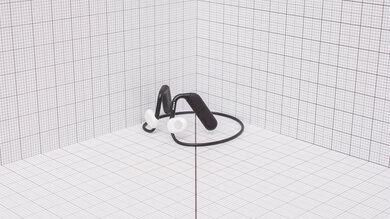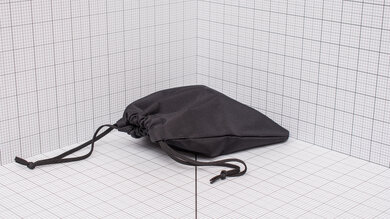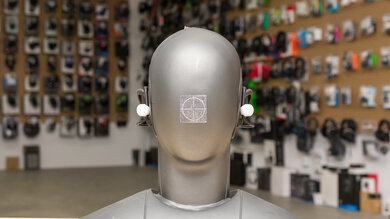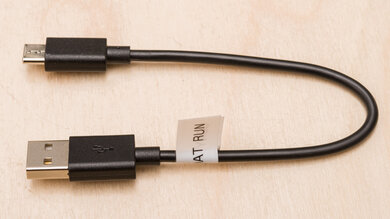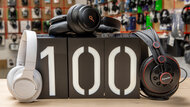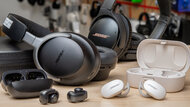The Sony Float Run are wireless sports headphones with a unique design. Their neckband and ear hooks feature two open-back dynamic drivers positioned slightly away from your ear. It allows for more ambient noise to enter your ear, permitting you to wear them during runs and instances outdoors where it's crucial to maintain spatial awareness. As a result, they struggle to properly reproduce bass, so mixes sound thin and flat. Fortunately, their battery life will last through long workouts and outdoor excursions. They're also rated IPX4 for resistance against water splashes but have slight issues with their build quality.
Our Verdict
The Sony Float Run are uniquely-designed sports earbuds and aren't designed for neutral sound. They fail to deliver any low or mid-bass, making audio sound thin and airy. Vocals and instruments sound detailed and present but muddy and harsh. However, sibilants, like cymbals, sound bright and clear. These headphones also have a relatively open-feeling passive soundstage, but it feels unnatural and closed-off.
- Long continuous battery life.
- Uncomfortable for long durations, especially if you wear glasses.
- Leak a lot of audio at high volumes.
The Sony Float Run are disappointing for commute and travel. Their open-back design means they won't isolate you from background noise, from bus engines to passenger chitchat. They also leak a lot of audio, which will likely bother those around you. Fortunately, their long battery life will last you through a long plane trip if you're stuck with them.
- Stable on-ear fit.
- Uncomfortable for long durations, especially if you wear glasses.
- Terrible passive noise isolation.
The Sony Float Run are decent for sports and fitness. Their stable around-ear fit and floating neckband will stay in place during tough workouts. They're also rated IPX4 for resistance against water splashes, which will help protect them during a run in the rain. However, they aren't comfortable if you wear glasses due to their weight and bulky shape. Audio may also get drowned out by ambient noise during a run down a busy street.
- Stable on-ear fit.
- Open-back design lets you hear your surroundings.
- Uncomfortable for long durations, especially if you wear glasses.
- Leak a lot of audio at high volumes.
The Sony Float Run are inadequate for office use. While they'll last a long day at the office without needing a recharge, using them for an extended duration will result in ear fatigue due to their bulky ear hooks. Their open-back design doesn't isolate you from ambient noise around the office, like clacking keyboards or coworkers' conversations. They also don't support multi-device pairing and leak a lot of audio, which can bother people around you.
- Long continuous battery life.
- Uncomfortable for long durations, especially if you wear glasses.
- Terrible passive noise isolation.
- Leak a lot of audio at high volumes.
The Sony Float Run aren't designed for wireless gaming. Latency via their Bluetooth-only connection is too high for this use.
The Sony Float Run are Bluetooth-only and aren't suitable for wired gaming.
The Sony Float Run are inadequate for phone calls. Their integrated mic makes your voice sound boxy and thin, and their unique open-back design means that people around you will likely hear your conversation.
- Stable on-ear fit.
- Uncomfortable for long durations, especially if you wear glasses.
- Terrible passive noise isolation.
Check Price
Differences Between Sizes And Variants
The Sony Float Run come in one color: 'Black'. You can see the label here. If you come across another variant, please let us know in the discussions, and we'll update our review.
Popular Headphones Comparisons
The Sony Float Run fit into an expanding category of wireless open-back sport headphones. While other models in this category, like the AfterShokz Aeropex Bone Conduction and the Shokz OpenRun Pro Bone Conduction, utilize bone conduction technology to bypass the ear altogether when delivering audio, The Sony have an off-ear design so that the drivers sit away from the ear and use speakers to play audio into them. Their build isn't as comfortable due to their heavier ear hooks, though their stability and sound profile are about the same as the Shokz models.
For more headphones, check out our recommendations for the best wireless earbuds for running and working out, the best headphones for running, and the best true wireless earbuds.
Both the Sony Float Run Wireless and Shokz OpenRun Pro Bone Conduction are designed to leave your ears open. For exercise, the Shokz are slightly better and more durable with dust resistance and a titanium frame. The Shokz use bone conduction to deliver audio and come in two sizes for finding your best fit. They lack bass but work well for vocals and lead parts, with a bigger passive soundstage. Unlike the Sony, they have a sturdy case. Their battery life is longer, but they use a proprietary charging cable. Sony's one-size-fits-most headphones use dynamic drivers so that you won't feel vibrations, and they lack bass but sound clear through the mids and treble. They use a standard USB-C charging port.
The Shokz OpenRun Bone Conduction are better headphones than the Sony Float Run Wireless. The Shokz are more comfortable, better built, and have longer continuous battery life. Both headphones are matched in stability performance and have very similar sound profiles. That said, both of these sports headphones do a terrible job delivering any bass-range audio and sound very thin.
The AfterShokz Aeropex Bone Conduction and the Sony Float Run Wireless perform similarly. Both headphones are equally stable on-ear, but the AfterShokz are more comfortable, better built, and have a longer continuous battery life than the Sony. However, the Sony have a more consistent frequency response and better mid and treble accuracy. Both headphones also deliver next to no bass-range sound.
The Bose Sport Earbuds Truly Wireless are better headphones than the Sony Float Run Wireless. The Bose are more comfortable, have better stability, and have a deeper bass extension than the Sony. However, the Sony have a longer continuous battery life and can better separate your voice from background noise during a call.
Test Results

These headphones have a very unique design. They have a bulky ear hook design that wraps around the front of your ear and connects to their neckband below. They don't enter your ear at all, and unlike other similarly designed headphones like the Shokz OpenRun Bone Conduction, they have two 16mm dynamic drivers in their hooks that 'float' off of your ears. They're only available in one color: 'Black'.
These headphones are reasonably comfortable. They're lightweight, and the ear hook fits well on most sized ears. However, comfort is greatly impacted if you wear glasses. They don't fit well over the arms of your glasses and can weigh them down, pushing them into the top of your ear and causing discomfort. It's more noticeable than with other similarly-designed sports headphones, like the Shokz OpenRun Bone Conduction.
These headphones have adequate controls. The three buttons on the right ear hook are relatively easy to use. They have good tactile feedback, and there are voice prompts to indicate power on/off, battery level, and Bluetooth connection status. However, because they're located on the end of the ear hook, your ears can inhibit access to the controls, depending on their size and shape.
Plus button ('+'):
- Single press: Raises the volume.
- Press and hold: Plays the next track.
Minus button ('-'):
- Single press: Lowers the volume.
- Press and hold: Plays the previous track.
Multi-function center button:
- Single press: Plays and pauses audio, answers and ends calls.
- Double press: Activates your device's voice assistant.
- Press and hold: Turns the headphones on and off.
These headphones are fairly portable. They don't fold into a more compact format, and they're bulkier than other sports headphones, like the Shokz OpenRun Bone Conduction. They won't fit in your bag or pocket without risk of damage, but you can wear them comfortably around the neck.
These headphones have a decent build quality. The hooks and driver housings are made of plastic, while the neckband is coated in a silicone-like material. The plastic casing around our unit's ear hooks has a small gap in it, which you can see here. The neckband also feels flimsy compared to other sports headphones like the AfterShokz Aeropex Bone Conduction. Fortunately, they're rated IPX4 for protection against water splashes, so long as you ensure the USB-C charging port's flap is closed securely.
The Sony Float Run have a warm sound profile. Vocals in podcasts and singer-centric genres like R&B sound detailed and present. Sibilants also sound bright and crisp. However, due to their unique open-ear design, the drivers 'float' too far away from your ears to adequately deliver bass. The low-mid range is overemphasized, making audio sound warm but muddy and cluttered. These headphones also don't have a companion app or sound customization options like an EQ or presets, meaning you're stuck with their default sound profile.
These headphones have remarkable frequency response consistency. They aren't prone to inconsistencies based on position or fit, and their audio delivery won't be affected if you wear glasses or have long hair.
Due to several design factors, these headphones can't deliver almost any low or mid-bass. What high-bass you can hear sounds warm, if not a little muddy. Out unit also has popping coming from the low bass range, which is annoying while listening to bass-heavy genres like hip-hop and EDM.
These headphones have great mid accuracy. An overemphasis in the high-bass range continues into the low-mid and makes vocals and lead instruments sound muddy. However, the rest of the mid-range is very well-balanced, making the synths in the breakdown to Pump Up The Jam by Technotronic sound clear and present.
These headphones have excellent treble accuracy. The whole range is well-balanced, making instruments and sibilants, like the cymbals in Call on Me by Eric Prydz, sound detailed and bright.
These headphones have sub-par peaks and dips performance. Due to their open-ear design, these headphones don't perform the same way in these tests as regular in, on, or over-ear headphones. Their design prevents them from delivering much, if not any, bass to your ear, so it's normal to see a dip present from the low bass to high-bass frequencies. An abnormally tall and wide peak from the high-bass to the low-mid results in instruments and vocals sounding muddy and boomy, and a small peak in the low-treble also makes instruments sound harsh.
These headphones have poor imaging performance. Sony is a very reputable company with good quality control and ergonomics. Treble reproduction is transparent, but our unit shows a mismatch between the L/R driver in group delay, indicating a loose bass. However, these headphones have trouble delivering bass to your ear, so this mismatch can be difficult to hear with real-life content. Unfortunately, we also noticed pops in this region when doing our sweeps, which can be annoying if you're listening to content with low-bass sounds.
The L/R drivers aren't well-matched in other tests, most notably in phase response. As such, sound objects, like instruments or sound effects, sound inaccurately placed in the stereo image, which also isn't well balanced. Keep in mind as well that imaging varies between units.
These headphones have sub-par passive soundstage performance. Their open-ear and open-back design means they sound open but don't interact with their environment to create a natural-feeling sound. It seems like audio is coming from close by rather than from all around the room.
These headphones have a middling weighted harmonic distortion performance. There are random popping noises in the bass range and further distortion at high volumes in the mid-range. As such, it's hard to ensure clean and clear audio, especially when listening to heavier genres like EDM and trap. If your unit also has experienced this issue, please let us know in the discussions below.
Due to their open-ear, open-back design, these headphones have very bad noise isolation performance. It's an advantage if you run outside in busy areas and need to hear the environment around you, but it won't be ideal for use on a bus or subway because they'll let in commuter chatter and rumbly engine noise.
These headphones have inadequate leakage performance. Like most open-back headphones, they leak a substantial amount of audio. Most escaping audio is in the treble range, so it sounds thin at high volumes and audible to those around you, even in busy environments like a loud office.
The integrated mic has fair recording quality. Your voice sounds thin and unnatural, though you're still understandable on the other end.
These headphones have a mediocre noise handling performance. You won't have trouble making calls from a quiet place, but loud traffic or a nearby passing train can easily make your voice sound boxy or drown it out completely.
These headphones have a mediocre battery performance. The manufacturer advertises them to last 10 hours continuously, and we measured just over that. This will get you through long runs and hikes without a recharge, but battery life can vary depending on usage. Fortunately, they have a standby mode that lasts 200 hours continuously, so they'll still have power for a few days if you forget to turn them off after a run.
These headphones have decent Bluetooth performance. They're designed for sports and fitness, so it's unlikely that you'll want to use them for PCs. That said, if you do, you'll experience sync issues when watching video content. However, latency is much lower with iOS and even better on Android, meaning you won't notice any audio lag while watching videos on your phone. It can vary, though, as some apps and devices compensate for latency differently.
These headphones have full audio and mic compatibility with PCs via Bluetooth. You can't connect them any other way.




